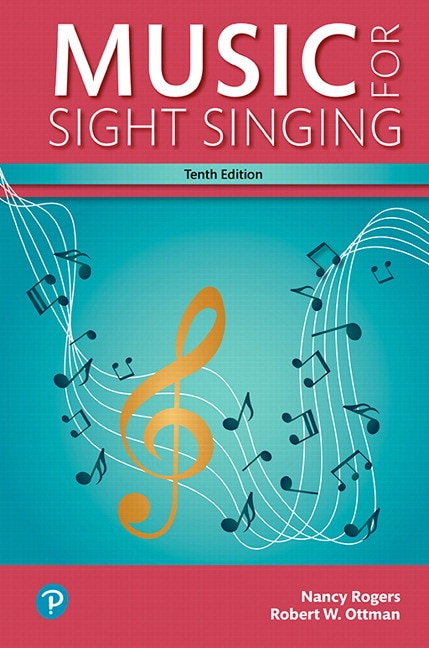
Music for Sight Singing, 10th edition
- Nancy Rogers
- , Robert W. Ottman

- Find it fast
Quickly navigate your eTextbook with search
- Stay organized
Access all your eTextbooks in one place
- Easily continue access
Keep learning with auto-renew
Music for Sight Singing is the most celebrated, engaging and musical sight-singing text on the market. Author Nancy Rogers explores organized melodies, drawn from the literature of composed music and a wide range of the world's folk music. Authentic music exercises allow you to practice sight singing and develop your “mind's ear,” the ability to imagine how music sounds without first playing it on an instrument. A simple-to-complex arrangement lays the foundation for success.
The 10th Edition offers a range of new content. The author introduces the minor mode more gradually, and presents leaps outside of the tonic and dominant harmonies more systematically. Fresh sections address mode mixture and augmented-sixth chords.
Published by Pearson (July 23rd 2021) - Copyright © 2019
ISBN-13: 9780137501724
Subject: Music
Category: Musical Training
PART I
MELODY: DIATONIC INTERVALS
RHYTHM: DIVISION OF THE BEAT
- RHYTHM: Simple Meters; The Beat and Its Division into Two Parts
- MELODY: Stepwise Melodies, Major Keys
RHYTHM: Simple Meters; The Beat and Its Division into Two Parts - MELODY: Leaps within the Tonic Triad, Major Keys
RHYTHM: Simple Meters - MELODY: Leaps within the Tonic Triad, Major Keys
RHYTHM: Compound Meters; The Beat and Its Division into Three Parts - MELODY: Minor Keys; Leaps within the Tonic Triad
RHYTHM: Simple and Compound Meters - MELODY: Leaps within the Dominant Triad (V); Major and Minor Keys
RHYTHM: Simple and Compound Meters - THE C CLEFS: Alto and Tenor Clefs
- MELODY: Further Use of Diatonic Leaps
RHYTHM: Simple and Compound Meters - MELODY: Leaps within the Dominant Seventh Chord (V7); Other Diatonic Seventh Leaps
RHYTHM: Simple and Compound Meters
PART II
MELODY: DIATONIC INTERVALS
RHYTHM: SUBDIVISION OF THE BEAT
- RHYTHM: The Subdivision of the Beat: The Simple Beat into Four Parts, The Compound Beat into Six Parts
- MELODY: Leaps within the Tonic and Dominant Triads
RHYTHM: Subdivision in Simple and Compound Meters - MELODY: Further Use of Diatonic Leaps
RHYTHM: Subdivision in Simple and Compound Meters
PART III
MELODY: CHROMATICISM
RHYTHM: FURTHER RHYTHMIC PRACTICES
- RHYTHM and MELODY: Syncopation
- RHYTHM and MELODY: Triplet Division of Undotted Note Values; Duplet Division of Dotted Note Values
- MELODY: Chromaticism (I): Chromatic Embellishing Tones; Tonicizing the Dominant; Modulation to the Key of the Dominant or the Relative Major
- MELODY: Chromaticism (II): Tonicization of Any Diatonic Triad; Modulation to Any Closely Related Key
- RHYTHM and MELODY: Changing Meter Signatures; The Hemiola; Less Common Meter Signatures
- RHYTHM and MELODY: Further Subdivision of the Beat; Notation in Slow Tempi
- MELODY: Chromaticism (III): Additional Uses of Chromatic Tones; Remote Modulation
PART IV
THE DIATONIC MODES AND RECENT MUSIC
- MELODY: The Diatonic Modes
- RHYTHM and MELODY: The Twentieth and Twenty-First Centuries
APPENDICES
- A. RHYTHM SOLMIZATION
- B. PITCH SOLMIZATION
- C. MUSICAL TERMS